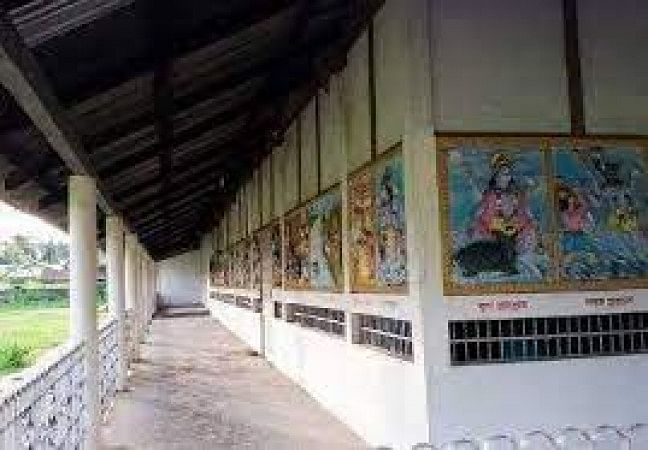Shyamrai Satra Travel Guide
Shyamrai Satra is a hidden gem nestled in the heart of Assam, India. Known for its rich history, breathtaking landscapes, and vibrant culture, this destination offers a unique travel experience for visitors. The Satra was established in the 19th century and serves as a spiritual hub for the followers of Vaishnavism. The serene surroundings of Shyamrai Satra provide a tranquil escape from the hustle and bustle of city life, making it a perfect destination for those seeking peace and rejuvenation.Top Attractions in Shyamrai Satra
- Visiting the historic Shyamrai Satra
- Exploring the lush greenery of the surrounding area
- Participating in traditional Vaishnavite rituals and cultural activities
- Interacting with the friendly locals and learning about their way of life
Shyamrai Satra is Famous for
Spiritual serenity and cultural heritage.Top Attractions in Shyamrai Satra
- Visiting the historic Shyamrai Satra
- Exploring the lush greenery of the surrounding area
- Participating in traditional Vaishnavite rituals and cultural activities
- Interacting with the friendly locals and learning about their way of life
What's Great about Travelling to Shyamrai Satra?
- Unique spiritual experience
- Peaceful and serene environment
- Opportunity to immerse in local culture
What's Not So Great about Travelling Shyamrai Satra?
- Limited accommodation options
- Remote location
- Language barrier for non-Assamese speakers
Travel Tips for Shyamrai Satra
- Carry cash as ATMs may be scarce
- Respect local customs and traditions
- Dress modestly while visiting religious sites
Important Shyamrai Satra trip information
- Ideal Duration: 2-3 days to explore the area
- Best Time to Visit: October to March for pleasant weather
- Nearby Airports and Railway Stations: The nearest airport is in Jorhat and the nearest railway station is in Mariani
FAQ's on Shyamrai Satra
Q1: What is the best time to visit Shyamrai Satra?
The best time to visit Shyamrai Satra is during the winter months from November to February when the weather is pleasant and ideal for exploring the cultural heritage of the region. Avoid the monsoon season from June to September due to heavy rainfall. Consider visiting during the festivals like Magh Bihu in January for a vibrant cultural experience.
Q2: Do I need a visa to travel to Shyamrai Satra?
Tourists visiting Shyamrai Satra need a valid Indian visa. However, travelers from select countries may be eligible for e-Visa or visa-on-arrival facilities. It is advisable to check the latest visa requirements and exceptions before planning your trip.
Q3: What are the must-visit attractions in Shyamrai Satra?
The top attractions in Shyamrai Satra include the historic Satras (monasteries), Majuli Island, Dakhinpat Satra, Auniati Satra, and Samaguri Satra. Explore the unique Neo-Vaishnavite culture, traditional mask-making, and vibrant festivals for an authentic experience.
Q4: Is Shyamrai Satra a safe place to travel?
Shyamrai Satra is generally safe for travelers. However, it is advisable to be cautious of petty thefts and take necessary precautions. Avoid isolated areas at night and follow local guidance for a secure travel experience.
Q5: What is the local currency in Shyamrai Satra and can I use credit cards?
The local currency in Shyamrai Satra is the Indian Rupee (INR). While major establishments accept credit cards in urban areas, it is recommended to carry cash for transactions in rural areas. ATMs are available in nearby towns for convenience.
Q6: What is the local cuisine like in Shyamrai Satra?
Shyamrai Satra offers a rich culinary experience with traditional Assamese cuisine. Enjoy dishes like Masor Tenga (sour fish curry), Aloo Pitika (mashed potatoes), and Pitha (rice cakes). Vegetarian and non-vegetarian options are available, catering to diverse palates.
Q7: What transportation options are available in Shyamrai Satra?
Transportation options in Shyamrai Satra include buses, taxis, and auto-rickshaws for local commutes. Renting a car or hiring a local guide is recommended for exploring nearby attractions like Majuli Island. Public ferries are also available for river crossings.
Q8: Are there any cultural norms or etiquette I should be aware of when visiting Shyamrai Satra?
When visiting Shyamrai Satra, respect local customs by dressing modestly, especially when visiting religious sites. Remove footwear before entering Satras and seek permission before photographing locals. Greet people with a 'Namaskar' and embrace the warm hospitality of the Assamese culture.
Q9: I am a travel agent. How can I buy travel leads of Shyamrai Satra?
Register yourself as a travel agent at agents.tripclap.com and then you can buy travel leads to Shyamrai Satra once your account is approved. For more details contact our support team at +91-8069186564 or support@tripclap.com

